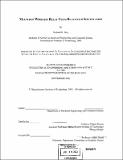Multi-hop wireless relay using Bluetooth specification
Author(s)
Moy, Richard K. (Richard Ken), 1979-
DownloadFull printable version (7.136Mb)
Other Contributors
Massachusetts Institute of Technology. Dept. of Electrical Engineering and Computer Science.
Advisor
Robert Morris.
Terms of use
Metadata
Show full item recordAbstract
This thesis presents BlueRelay, a novel protocol that extends the Bluetooth specification to support multi-hop wireless communication. Bluetooth is a wireless communication protocol originally designed for point-to-point communication within a small network called a piconet, where a master has centralized coordination over slave devices. The purpose of BlueRelay is to enable inter-piconet communication using existing Bluetooth mechanisms without any modifications to the Bluetooth link layer and its medium access control protocol. BlueRelay is a two-part protocol. First, the relay establishment process details how a slave device establishes communications with two master devices and acts as a forwarding node between two piconets. Second, the piconet switching scheme employs a Bluetooth mechanism called the HOLD mode to enable a slave to switch back and forth between two piconets. These two techniques allow Bluetooth devices to forward packets over multiple hops and beyond the communication range of the source's transmitter. BlueRelay is simulated in a Bluetooth simulator that was developed by IBM to simulate the Bluetooth protocol stack. By simulating the relay establishment process and the piconet switching scheme in the Bluetooth simulator, we demonstrate that multi-hop wireless communication can be achieved using the existing mechanisms of the Bluetooth specification. Simulation results show that relay establishment occurs under 10 seconds and a maximum of 300 kbps average throughput can be achieved for multi-hop wireless communication. End-to-end latency ranges from 15ms per hop to 300ms per hop, depending on the HOLD period.
Description
Thesis (M.Eng.)--Massachusetts Institute of Technology, Dept. of Electrical Engineering and Computer Science, 2002. Includes bibliographical references (p. 85-87).
Date issued
2002Department
Massachusetts Institute of Technology. Department of Electrical Engineering and Computer SciencePublisher
Massachusetts Institute of Technology
Keywords
Electrical Engineering and Computer Science.